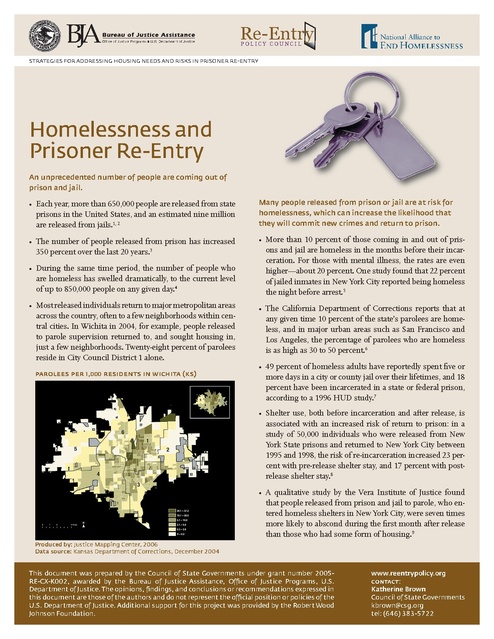Homelessness and Prisoner Re-Entry, BJA, 2006
Download original document:

Document text

Document text
This text is machine-read, and may contain errors. Check the original document to verify accuracy.
Re-Entry POLICY COUNCIL strategies for addressing housing needs and risks in prisoner re-entry Homelessness and Prisoner Re-Entry An unprecedented number of people are coming out of prison and jail. • Each year, more than 650,000 people are released from state prisons in the United States, and an estimated nine million are released from jails.1, 2 Many people released from prison or jail are at risk for homelessness, which can increase the likelihood that they will commit new crimes and return to prison. • The number of people released from prison has increased 350 percent over the last 20 years.3 • More than 10 percent of those coming in and out of prisons and jail are homeless in the months before their incarceration. For those with mental illness, the rates are even higher—about 20 percent. One study found that 22 percent of jailed inmates in New York City reported being homeless the night before arrest.5 • During the same time period, the number of people who are homeless has swelled dramatically, to the current level of up to 850,000 people on any given day.4 • Most released individuals return to major metropolitan areas across the country, often to a few neighborhoods within central cities. In Wichita in 2004, for example, people released to parole supervision returned to, and sought housing in, just a few neighborhoods. Twenty-eight percent of parolees reside in City Council District 1 alone. parolees per 1,000 residents in wichita (ks) • The California Department of Corrections reports that at any given time 10 percent of the state’s parolees are homeless, and in major urban areas such as San Francisco and Los Angeles, the percentage of parolees who are homeless is as high as 30 to 50 percent.6 • 49 percent of homeless adults have reportedly spent five or more days in a city or county jail over their lifetimes, and 18 percent have been incarcerated in a state or federal prison, according to a 1996 HUD study.7 • Shelter use, both before incarceration and after release, is associated with an increased risk of return to prison: in a study of 50,000 individuals who were released from New York State prisons and returned to New York City between 1995 and 1998, the risk of re-incarceration increased 23 percent with pre-release shelter stay, and 17 percent with postrelease shelter stay.8 • A qualitative study by the Vera Institute of Justice found that people released from prison and jail to parole, who entered homeless shelters in New York City, were seven times more likely to abscond during the first month after release than those who had some form of housing.9 Produced by: Justice Mapping Center, 2006 Data source: Kansas Department of Corrections, December 2004 This document was prepared by the Council of State Governments under grant number 2005RE-CX-K002, awarded by the Bureau of Justice Assistance, Office of Justice Programs, U.S. Department of Justice. The opinions, findings, and conclusions or recommendations expressed in this document are those of the authors and do not represent the official position or policies of the U.S. Department of Justice. Additional support for this project was provided by the Robert Wood Johnson Foundation. www.reentrypolicy.org contact: Katherine Brown Council of State Governments kbrown@csg.org tel: (646) 383-5722 homelessness and prisoner re-entry State and local budgets cannot sustain spending on shelter and emergency costs to serve increasing numbers of people who are homeless; long-term housing solutions can decrease the costs associated with people who would otherwise become homeless, such as people released from prison and jail. • In New York, it costs more than $32,000 per year to serve a single person who stays in homeless shelters and returns to prison. Hospitalizations and child welfare involvement drive this price tag even higher.10 • Prison and jail are among the most expensive settings to serve people who are homeless: one nine-city study calculated median daily costs for prison and jail at $59.43 and $70.00 respectively, compared with $30.48 for supportive housing.11 • Supportive housing has been documented to drastically reduce criminal justice involvement, reducing jail incarceration rates up to 30 percent and prison incarceration rates up to 57 percent.12 • According to a cost analysis by the Corporation for Supportive Housing, a single re-entry housing unit in New York used by two people over one year can save $20,000 to $24,000 relative to the cost of release to shelter and re-incarceration.13 Organizations have developed different housing interventions to prevent homelessness and promote independence and self-sufficiency among re-entering offenders in several states. St. Leonard’s Ministries and Lakefront SRO (Single Room Occupancy) work in partnership to provide second-stage housing and support services to men released from prison to the Chicago area, who have graduated from St. Leonard’s short-term re-entry programs. St. Andrew’s Court comprises 42 affordable housing units for single men with a range of risks and needs. Funding partners include the Illinois Housing Development Authority, the City of Chicago’s St. Andrew’s Court (Chicago, IL): 1. The number of people released from state prisons each year been steadily increasing—from slightly more than 600,000 in 2000 to more than 670,000 in 2004. See Paige M. Harrison and Allen J. Beck, “Prison and Jail Inmates at Midyear 2005,” US Department of Justice, Bureau of Justice Statistics (Washington, DC: 2006), NCJ 213133. 2. The jail numbers (2004) were provided by Allen J. Beck, “The Importance of Successful Reentry to Jail Population Growth” (presentation at The Jail Reentry Roundtable of the Urban Institute, Washington, DC, June 27, 2006). 3. James P. Lynch and William J. Sabol, Prisoner Reentry in Perspective, Washington, DC: The Urban Institute, September 2001. 4. Martha R. Burt et al., Homelessness: Programs and the People They Serve: Findings From the National Survey of Homeless Assistance Providers and Clients, U.S. Department of Housing and Urban Development (Washington, DC: 1999), cited in Stephen Métraux and Dennis P. Culhane, “Homeless Shelter Use and Reincarceration Following Prison Release: Assessing the Risk,” Criminology & Public Policy 3, no. 2 (2004): 201–222. 5. Métraux and Culhane; David Michaels et al., “Homelessness and indicators of mental illness among inmates in New York City’s correctional system.” Hospital and Community Psychiatry 43 (2002):150–155. Department of Housing, the Illinois Department of Corrections, the Federal Home Loan Bank, and various foundations. St. Leonard’s provides an array of case-management services, and a self-governed Residents’ Council meets regularly. Alliance Apartments offers 100 permanent, affordable housing efficiency apartments and 24 transitional housing units, where residents may stay for up to two years, for homeless, single adult men and women who make a commitment to work, remain chemicalfree, and live in a drug-free community. Although Alliance Apartments doesn’t include units specifically designated for formerly incarcerated individuals, many tenants have recently been released from jail or prison. On-site staff from partner organization RS Eden provide case management, counseling, peer support networks, social and recreational events, and linkages to mental health services as well as education, training and work programs, and work on an informal basis with parole officers and supervision agents. In 1995, Alliance Housing received 100 Section 8 Certificates to create affordable housing; RS Eden received a state grant through the Department of Corrections to provide support services to people coming out of incarceration. Alliance Apartments (Minneapolis, MN): The Fortune Academy, a residential facility in West Harlem opened in 2002, provides 18 emergency and 41 longer-term beds and access to the Fortune Society’s array of supportive services. Prospective clients must be formerly incarcerated, homeless, pose no current risk of violence, and have an interest in and be appropriate for the services being provided. Residents of the Academy are required to provide 10 hours of service to the house and attend weekly house meetings. Although sobriety is not a requirement for placement in the housing facility, residents must demonstrate motivation to become sober. Individuals in emergency housing often go on to live at the Academy longterm. The duration of long-term housing is determined on an individual basis. Generally residents live in housing between six months to a year—until they have stabilized and can be linked to permanent housing, which is often coordinated by Fortune’s housing specialists. Fortune Academy (New York, NY): 6. California Department of Corrections, Prevention Parolee Failure Program: An Evaluation (Sacramento, CA: California Department of Corrections, 1997). 7. Burt et al. 8. Métraux and Culhane. 9. Marta Nelson, Perry Deess, and Charlotte Allen, The First Month Out: Post-Incarceration Experiences in New York City (New York, NY: Vera Institute of Justice, 1999). 10. Corporation for Supportive Housing, “Re-entry housing promotes public safety while saving public dollars,” cost analysis based on data provided by the New York State Division of Parole, 2006. 11. The Lewin Group. 2004. “Costs of Serving Homeless Individuals in Nine Cities.” Chart Book Report. New York, NY: Corporation for Supportive Housing. 12. Dennis P. Culhane et al. “Public Service Reductions Associated with Placement of Homeless Persons with Severe Mental Illness in Supportive Housing,” in Housing Policy Debate, Vol. 13, Issue 1. Fannie Mae Foundation. 2002. 13. Corporation for Supportive Housing.





